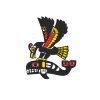 The Cowichan Watershed is home to many fish species. This is a function of both the size of the watershed and its incredible ecological richness as habitat and in terms of nutrients.
The Cowichan Watershed is home to many fish species. This is a function of both the size of the watershed and its incredible ecological richness as habitat and in terms of nutrients.
The ecological health of the watershed is reflected in the health of its fish. It’s a mutual relationship. Healthy fish make a healthy watershed, and vice versa.
Click here for a table listing the fish in the Cowichan Watershed. The table shows fish presence recorded in a number of streams and three lakes in the watershed, and indicates whether they are exotic/introduced species, and shows their BC Conservation and COSEWIC status.
On this page we look at a few representative fish of the Cowichan Watershed, including some “Salmonids”, which are the most abundant and ecologically and economically the most important fish, at “Exotic/Introduced” species, and a couple of “Rare or Endangered” fish.
“Anadromous” is the term used to describe fish which spend some part of their lives in fresh water and some in salt water. Salmon are anadromous.
It is fascinating fact that within the same species fish, some are anadromous, and some live their entire lives exclusively in fresh water. Coastal Cutthroat is an example. Oncorhyncus mykiss the Rainbow Trout is another. Cowichan is also home to Kokanee, the fresh water variant of Oncorhyncus nerka, but the watershed does not have an established run of Sockeye Salmon, the anadromous fish.
The most plentiful salmon in the Cowichan system are Chum salmon, which annually appear in the tens of thousands. Whenthey die after spawning they contribute hundreds of thousands of kilograms of nutrients to the watershed. Recently only a few thousand Chinook and Coho have been spawning in the watershed.
SALMONIDS
Salmon
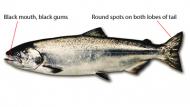 Chinook (Oncorhynchus tshawytscha)
Chinook (Oncorhynchus tshawytscha)
– At least 1 year in fresh water; 1-5 years in the ocean.
– Largest of the Pacific salmon, highly important sport fish.
– International “indicator” fish.
– Historic low populations in Cowichan in the past several years: low thousands in recent years versus tens of thousands in 1970s.
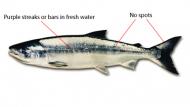 Chum (Oncorhynchus keta)
Chum (Oncorhynchus keta)
– Fry leave almost immediately for the ocean, return after 2 to 6 years.
– Most abundant salmon on Pacific coast, numerically and in terms of body mass.
– Described as a “marine nutrient pump” as they aggregate marine nutrients and transport them into coastal watersheds.
– High spawner returns in Cowichan: avg 150,000 per year in recent years
 Coho (Oncorhynchus kisutch)
Coho (Oncorhynchus kisutch)
– 1 to 2 years in fresh water and 18 months or so at sea.
– Tend to hang around coastal areas rather than heading to deep ocean
– Excellent and abundant sport fish
– Historic low populations in Cowichan: low thousands in recent years versus tens of thousands in 1970s.
 Kokanee (Oncorhynchus nerka)
Kokanee (Oncorhynchus nerka)
– Maximum length: 60 cm.
– Kokanee are Sockeye salmon that spend their entire lives in fresh water.
– Kokanee eat zooplankton, not other fish.
– A Rainbow trout will eat two Kokanee a day.
 Steelhead (Oncorhynchus mykiss)
Steelhead (Oncorhynchus mykiss)
-searun rainbow trout
-1 to 5 years in fresh water, 1 to 4 years at sea
– Cowichan steelhead are winter-run (return late December to March)
– Returns 500-800 per year over last ten years, likely 2000 or more in 1980s
– High value sport fishery
Trout
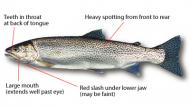 Coastal Cutthroat (Oncorhynchus clarkii clarkii)
Coastal Cutthroat (Oncorhynchus clarkii clarkii)
– Maximum length: 76 cm.
– Anadromous and freshwater forms.
– Blue-listed (vulnerable) in BC.
– Particularly at risk on east side of Vancouver Island, where many runs are
already extinct.
– Dependence on small streams for spawning and rearing makes them especially
vulnerable.
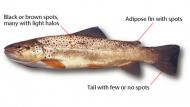 Brown Trout (Salmo trutta)
Brown Trout (Salmo trutta)
– Can exceed 50 cm.
– Popular angling fish on the Cowichan River.
– Brought to North America from Scotland in 1884.
– Introduced to BC as hatchery fish in 1932.
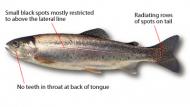 •Rainbow Trout (Oncorhynchus mykiss)
•Rainbow Trout (Oncorhynchus mykiss)
– Maximum length: 90 cm.
– Coastal type found in all of BC’s coastal rivers.
Char
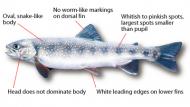 •Dolly Varden (Salvelinus malma)
•Dolly Varden (Salvelinus malma)
– Up to 45 cm
– Blue-listed (vulnerable) in BC.
– Anadromous and freshwater forms.
– The only fish on this page named after a Dickens character.
RARE/ENDANGERED SPECIES
Cowichan Lake Lamprey (Lampetra macrostoma)
– Up to 26 cm.
– Found only in Cowichan Lake and Mesachie Lake – and nowhere else on Earth.
– In one study in Mesachie Lake, as many as half the salmon and trout sampled had scars from lampreys.
– It is locally abundant, and does not seem to be under obvious threat. Due to its extremely limited range it is red-listed in BC and has been designated as Vulnerable by COSEWIC
ALIEN/EXOTIC/INTRODUCED SPECIES
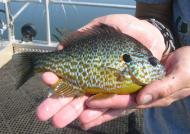 Pumpkinseed Sunfish (Lepomis gibbosus)
Pumpkinseed Sunfish (Lepomis gibbosus)
– Rarely exceed 20 cm.
– Native to eastern and central North America, alien species in western NA.
– Threat to freshwater biodiversity and to indigenous fish species in BC.
– At present only recorded in Somenos Lake in Cowichan Watershed
Brown Trout see above, in Trout
Related Resources
Fish – A Cowichan Watershed Overview
Tom Rutherford, July 2010
Pacific Salmon
Fisheries and Oceans Canada
Sport Fish of B.C.
B.C. Fish Facts
BC Ministry of Environment
 Email
Email